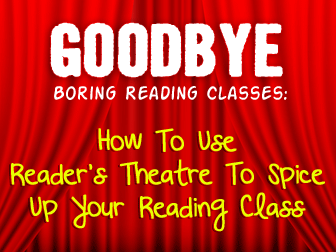Goodbye, Boring Reading Classes: Using Readerís Theatre To Spice Up The Reading Class


I learned a lot from working with actors, but more importantly, I got some practical ideas to spice up the way I worked in the classroom. If you just want to read the ideas, skip to the end of this article. If you’d like to hear more about the work of the ETT, read on….

The English Teaching Theatre was an idea that started at International House in London, and developed into a professional theatre company that toured the world for about thirty years, undertaking more than 250 tours to fifty-five countries. We did shows for both private organisations and state schools (public schools in US English).
"The show we performed was a series of sketches, songs, games and the occasional magic act. In between these events, one or two actors would engage in some kind of noisy interaction with the audience. The language we used was low intermediate level, although we could up the level in the interactive parts if we could see that an audience were dealing with it quite easily."
It was not a show that could be watched passively. It was essential that the audience got involved, shouting out answers, singing the songs and occasionally flooring us with a witty (if sometimes rude) comment. For one or two members of the audience, there would be the chance to come on stage to take part in a team game of some kind.
The shows we did for private schools were usually fun, with good theatre venues and compliant audiences, who would take part in the audience participation sections and not cause any trouble. If anything, it was more of a problem if the audiences were a little too well behaved.

The audiences at state school shows were usually the same as the ones at private schools, but occasionally they were more challenging. The theatre space wasn’t always perfect and the audience might have been herded into the auditorium against their will at an ungodly hour of the morning. Eight o’clock in the morning is a time when most British actors are still contemplating another five hours sleep and most students don't much like being awake at that time, either.
“Eight o’clock in the morning is a time when most British actors are still contemplating another five hours sleep and most students don't much like being awake at that time, either.”
However, it felt very satisfying when we managed to succeed in a situation like that, for example, doing an energetic early morning show in a school canteen in an industrial suburb of a Central European city.
In some countries, we were invited to do shows in what locals referred to as 'rough areas'. If they thought that those areas were rough, they had clearly never visited schools in some of the deprived urban areas of the UK. At the same time, we recognised that it was hard for the teachers working in places where classroom management was probably a bigger challenge than teaching the various uses of the present perfect.
There were one or two schools in those rough areas that I would never want to visit again and I have maximum respect and sympathy for the teachers who do work there. Even so, there weren’t actually that many audiences that we couldn't find coping strategies for. Looking back at our many adventures on the road, it is almost always the successes we had in these initially unattractive venues that we look back on with most pleasure.
However, after a very difficult show in the Netherlands, when a bunch of teenage boys shouted some extremely rude things at us (in perfect English - how did they learn to swear so effectively in a foreign language??), we decided we had to do something to deal with potential problem areas in the audience. Until this point, we had simply bounded energetically on stage, said a loud “Hellooooo!” to the audience and started the opening song, which would require a degree of simple participation from the audience.
After this particular landmark show, we decided to change the way we did things. In future, we would have a pre-show activity, where the five performers would go into the audience and chat with different groups of students. With a 'nice' audience, this was very pleasant and engaging, and it also gave us a chance to choose bright, confident and articulate students who could join us on stage. With potentially difficult audiences, we could connect with people who had possibly come to the show with the intention of disrupting it. Either way, it turned out to be the best idea ever, creating a link with the audience which continued through the performance.
Some of the actors who subsequently joined the show were initially skeptical about the idea of connecting with the audience in this way before the show actually started. One of the things that is drummed into actors at drama school is the importance of the fourth wall, the imaginary one that separates the stage from the audience. Even when you're doing a comedy play, received wisdom is that you can't break the convention of the fourth wall. In other words, you can't actively acknowledge the existence of an audience. The British Christmas tradition of pantomime clearly breaks this rule, and many actors make much-needed money with this kind of seasonal work, but even so, many of them found the idea of connecting with the audience, actually talking to them from the stage, quite a challenge, but new performers had to quickly get used to it.
As I’ve already said, I have a lot of respect for the teachers who work in challenging schools, and I also have a lot of sympathy for the students who attend them. I think in the world of ELT, we tend to avoid talking about students whose social circumstances are complicated. When we discuss motivation, there is a tendency to concentrate on the problems experienced by more, for want of a better word, middle-class students.
I completely understand this. A lot of native speaker teachers of English work in the kind of conditions that I experienced. My first teaching job was in Spain, at the Instituto Británico in Seville, where the students paid a lot of money, or their parents did, and if they didn't turn up to class, their money was wasted. And the parents provided strong motivation for their children to attend.
When I then started working at International House London, it was a typical private language school set-up: a maximum of fourteen students seated in a semi-circle, the best technology available (not much in those days, but state-of-the-art) and the most important commodity of all, English outside the classroom. Between classes, students were surrounded by English.
What percentage of English classes worldwide are like this? I would imagine less than five per cent. Teachers and students who work and study in these situations have a lot of advantages, and personally I prefer to think about how to motivate students with fewer benefits. If you can think of ways to help the least motivated students, the chances are that the ideas and techniques you come up with will be useful with all students.
_____________________________
So finally, here are some practical teaching ideas, some of which I got from performing on stage, which I now try to incorporate into classroom practice. They are all about finding better ways to connect, and I hope they are useful with students with low motivation.
In my opinion, there’s something wrong if the teacher walks into the classroom, and the students are sitting there with their course books open at the page they had reached when the last class finished. It suggests a class which is dominated by the contents of the book, when it should, at least at the beginning, be dominated by what’s inside the students’ heads at that particular moment. The teacher needs to key into that so …
As I explained earlier, experience with our touring theatre show told us that we couldn’t just walk on stage and hope everything would be OK. Our audiences were not regular theatre audiences, which is why we came up with the pre-show activity to connect with them. In the same way, a lot of our classroom students are not academically minded. You can’t just walk in and plough straight into a grammar lesson. I’m sure no one reading this would ever DREAM of doing that. So ….
The opening conversation you have with your students should engage their interest and attention. This really isn’t as difficult as it sounds. However, simply asking “What did you do at the weekend?” isn’t very engaging, particularly the fourth or fifth time you ask it. Find a piece of news (not too serious) and start with that. And if possible….
This really is the best way to engage your students. Maybe start by looking at a photo or reading a small piece of text that isn’t completely clear. It’s particularly good if the photo and/or text come from the book you are using. Course books often have good pre-reading tasks, and they may work better if the task is separated from the text. For example, if the pre-reading task is Look at the photograph and decide what the reading text is about, it’s good to separate the task and the photo from the text, by displaying them on a screen, with books closed.
A teacher I talked to recently told me that she has to present her lesson plans to her DoS every day. I must say I have never had to do that. What does the DoS do with it? Check with you afterwards that you did everything you said you would do? Are you allowed to put a section in the lesson plan that says ‘Follow the trail of anything interesting that comes up’? Although I would never recommend taking a class without a lesson plan, I do feel that teachers should be encouraged to let the class go in the direction that an interesting discussion might take it. It’s a basic tenet of the Dogme Teaching Unplugged movement, but one that teachers should use, whatever their choice of methodology.
In my working life as a writer of ELT course materials, I get to watch other people teaching, and I’m almost always impressed by what I see. However, I have sometimes noticed that teachers worry if the atmosphere is too ‘light-hearted’ during the class. When we talk about the lesson afterwards, many of them apologise for the fact that there was laughter during the class, often caused by something funny that one of the students said. I always tell them that laughter is one of the great aides memoires of the learning process. That’s why people remember funny stories. Never stop your class from laughing, it’s good for them. Always allow a bit of light relief into every lesson.
“Laughter is one of the great aides memoires of the learning process.”
If you have a desk, sit on it, not behind it. I shouldn’t have to tell you how much sitting behind a desk disconnects you from the class.
“If you have a desk, sit on it, not behind it.”
I watched a wonderful class given by a Polish teacher of English once, where she worked hard with maximum energy for fifty minutes and then – this was so good to see – she walked around her class of twenty students and thanked them all individually for their participation. It was a lovely moment!
What I tried to do in this article was explain how my thoughts on the classroom process were influenced by working with a theatre company with an interactive style. I hope you found it useful.
If you would like to read more about the early days of the English Teaching Theatre, you can find information on Ken’s blog